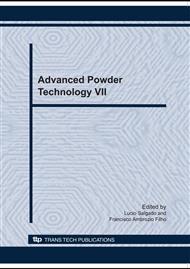p.1015
p.1019
p.1025
p.1031
p.1037
p.1043
p.1049
p.1053
p.1058
Comparative Study of Organophilic Clays to be Used in the Gas & Petrol Industry
Abstract:
Brasgel clay and Gray clay has been been subjected to modification through ion-exchange reaction by quaternary ammonium (cetyltrimethyl ammonium bromide, CTAB). The samples were studied by X-Ray Diffraction, Infrared Spectroscopy, Scanning Electron Microscopy (SEM) and the Foster’s Swelling test. The results indicated that the quaternary ammonium salts were intercalated between the layers of clay. The basal spacing of unmodified Brasgel clay, determined by XRD, was 1.329 nm and after modification it increased up to 2.101 nm. By analyzing the results obtained in this study, particularly those provided by infrared spectroscopy, it was concluded that the treated, organophilic sample (modified with CTAB) comprised CH2 and CH3 groups in its structure, which provides evidence of the efficiency of the organophilization process. Foster´s swelling was carried out with and without agitation in gasoline, diesel, toluene and lubricating oil. The results indicated the samples was organophilic materials, with improved efficiency of Brasgel clay in gasoline and diesel and when compared to Gray clay in the test of capacity for adsorption and Foster´s swelling, the results were similar to kerosene and lubricating oil.
Info:
Periodical:
Pages:
1037-1042
Citation:
Online since:
October 2010
Keywords:
Price:
Сopyright:
© 2010 Trans Tech Publications Ltd. All Rights Reserved
Share:
Citation:


